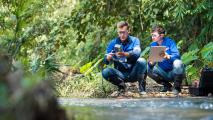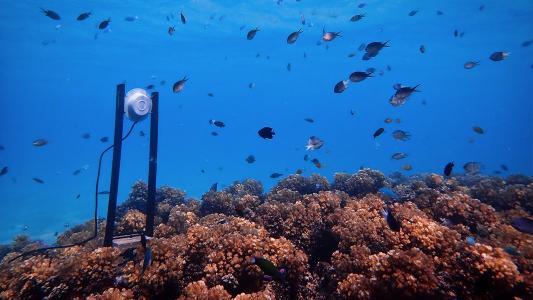The sea level around Charleston, S.C., is rising by about half an inch every year — a consequence of warming oceans, melting ice, and sinking land.
But Sam Norton, local founder of Heron Farms, is seizing the opportunity and using the world’s most abundant resource — seawater — to grow food.
But it’s not fish, or seaweed. Instead, the farm is the world’s first indoor saltwater hydroponics farm. Their foundational crop: sea beans!
From lemons to lemonade: Norton is no stranger to rising waters. Growing up on a barrier island off the coast of South Carolina, his family home flooded more and more each year.
“I grew up in one of these towns where sea level rise is already a fact. It’s not really political anymore. It’s just becoming part of the landscape.”
Ssam Norton
“I grew up in one of these towns where sea level rise is already a fact. It’s not really political anymore. It’s just becoming part of the landscape,” he said.
When he traveled to Bangladesh and saw coastal rice terraces flooded with saltwater, impacting the farmers’ lives, Norton began to wonder how we could turn the problem of the encroaching seawater into an opportunity.
That is when he came up with the idea for Heron Farms — an indoor saltwater hydroponics farm growing salt-tolerant plants, called Salicornia, for food.
“If you need salt, water, and carbon dioxide to do photosynthesis with these salt-tolerant plants, and saltwater and carbon dioxide are both problems of excess, then they are free resources. So it seems too good to be true,” he said.
Down on the farm: Sea beans, also known as Salicornia europaea, are an edible plant that thrives in salt marshes. It has evolved to live in salt throughout its entire life cycle — which is why Norton chose the sea bean for his first crop.
“If you need salt, water, and carbon dioxide to do photosynthesis with these salt-tolerant plants, and saltwater and carbon dioxide are both problems of excess, then they are free resources. So it seems too good to be true.”
Sam Norton
“It’s known under all sorts of strange names as a food: sea beans, sapphire, sea pickles, sea asparagus. It is in the spinach family, so it is genetically similar to spinach and beets,” Norton said, adding that it sequesters salt. The sea bean stores salt in its cells to regulate its natural environment.
“It actually tastes like biting into the ocean a little bit. It’s like a healthier version of sea salt,” he said.
According to a 2018 report, published in the scientific journal Environmental Science & Technology, more than 90% of salts marketed across the world contain microplastics. Heron Farms intends to advertise their crop as a better salt alternative, reports Charleston Regional Business Journal.
Around the world: Norton isn’t the only one trying to tap into the abundance of seawater. Camila Reveles is growingSalicornia outdoors in one of the saltiest places on earth — the solar saltworks of Brazil.
A Canadian startup called Agrisea plans to help rice farmers in the Mekong Delta, who much like the farmers of Bangladesh, have suffered from drought and saline intrusion.
It turns out many plants, including rice, already have eight critical genes related to salt tolerance. Plants that have all eight of these genes turned on can grow and even thrive in seawater, but although present, they are turned off in rice. The Agrisea team is using CRISPR to turn on one gene at a time until they have a rice plant with all eight genes activated, a variety they hope will thrive in salty paddies.
Reveles, Norton, and others doing similar work may be ahead of the game. According to Jose Dinneny, a Stanford University plant scientist, future farmers will be forced to cultivate crops on marginal terrain, which is normally not utilized for agriculture owing to salt in the soil or a lack of rainfall. But the work that Norton and other innovators and startups are doing today will prepare farmers of tomorrow to transform the problem into an opportunity, as we feed a growing population.
We’d love to hear from you! If you have a comment about this article or if you have a tip for a future Freethink story, please email us at [email protected].






